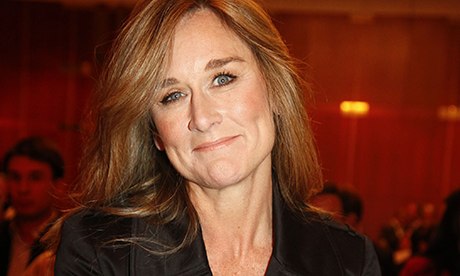
What will Angela Ahrendts' move mean more broadly for the consumer electronics market? Photograph: Bloomberg via Getty Images
With Apple apparently losing its mojo since the death of Steve Jobs, the appointment of Angela Ahrendts seems like an inspired move. The Burberry chief executive turned around a business that was more associated with football hooligans than high fashion, and while Apple might not need such a dramatic turnaround, as a brand famed for product invention, the need for retail innovation is ever present.
Part of Burberry's success can obviously be attributed to Christopher Bailey and his vision and creativity – we can all remember the Kate Moss swimsuit ad that almost single-handedly propelled the brand back into the luxury fashion stratosphere. However, it was Ahrendts' innovative approach that has truly transformed the business. Relaunching the online store and reinventing the physical store has reaped huge rewards for Burberry, while the acceleration of the retail portfolio with bold moves into untapped markets has been impressive.
What particularly interests me about this move is the true opportunity that lies in the convergence of high technology and high fashion. Who wants to wear Google glasses when you can wear Gucci? Or HP when you can have Hermes? Ahrendts' appointment would seem a natural fit for a brand that could well lead the way in wearable technology – probably likely to be the single most influential trend over the next couple of years, and a category that is about to explode.
Or to quote Richard Stoppard, global head of retail strategy at Nokia: "The convergence of beauty of design and pack-leading technology is at the core of Nokia and continues to drive the mobile category. As key players begin to explore wearable technology, it is clear that recruiting visionary leaders who understand the fusion of design, fashion and technology such as Ahrendts will drive true benefits."
So what will this mean more broadly for the consumer electronics category?
Fashion has always been about aspiration and lifestyle, and the world of consumer electronics has produced some almost magical products. So why has the consumer electronics category behaved more like the kitchen appliances category? Perhaps we'll start to see the long overdue demise of the "techs and specs" approach to a more "desires and dreams" vernacular? After all, the price of the average laptop far exceeds the price of your average pair of shoes.
Fashion brands have always created stores that allow shoppers to dream – in fact, many are cathedrals to the brand, every detail considered, every material interrogated and every vista choreographed. An almost solitary but sparkling example of these principles at work is in the Vertu store in Ginza, Tokyo. The environment was created from the beauty and craft of the devices outwards. The brand stands for the elegance of the extraordinary and the environment is tailored to reflect that ethos.
Shopping is now an event and a social experience – it's the difference between "doing" the shopping and "going" shopping. One is a chore that has to be endured (and more often than not online) and the other is entertainment. Consumer electronics have generally failed spectacularly to deliver anything close to entertainment – ironic considering the product they are selling. The old view that shoppers can touch and feel in-store and will therefore purchase is simply not enough.
Fashion brands know how to create that "must have now" moment. Take the Mulberry store on Bond Street. Sure, you can buy a bag online (and probably cheaper) but when you cross the threshold of the store you enter the Mulberry world. It is a monument to British craft – the dry stone wall doesn't just add texture to the environment; it adds texture to the experience.
It doesn't even have to be the luxury end of fashion that consumer electronics can learn from. What if Topshop did consumer electronics? Masterclasses from the coolest tech geeks; an audio department that feels like a nightclub; and a TV lounge where shoppers can hang out with friends and choose a movie, all served up with popcorn and ice cream.
Fashion brands have always strived to match the dream of their brand with the reality of the physical environment. In contrast, the magic of technology and how it is retailed always seems to fall short of our expectations. After all, the physical store is still the greatest opportunity a brand has to wow you with its thinking, its story and its products.
Stuart Wood is creative partner at Missouri Creative – you can also follow the company on Twitter @WerMissouri
Get more articles like this sent direct to your inbox by signing up for free membership to the Guardian Media Network – this content is brought to you by Guardian Professional .
via fashion - Google News http://news.google.com/news/url?sa=t&fd=R&usg=AFQjCNGZ5cyQ74czwk6dfX4TftPAxVhiGg&url=http://www.theguardian.com/media-network/media-network-blog/2013/oct/17/angela-ahrendts-apple-burberry-technology-fashion




0 意見:
張貼留言